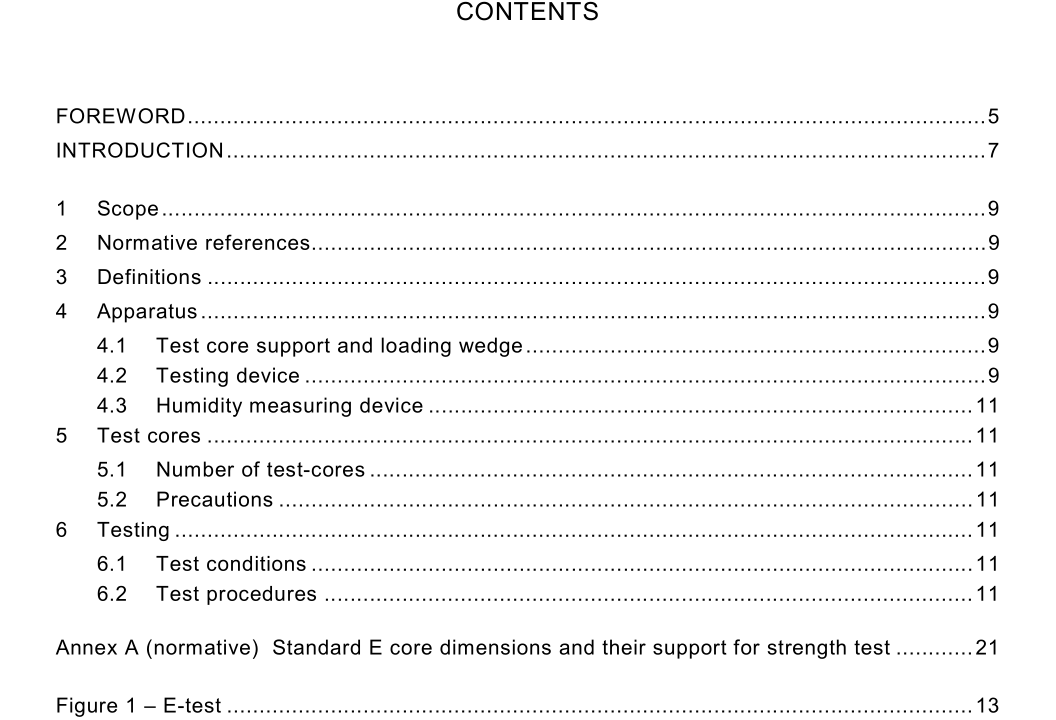IEC 61631 pdf download

IEC 61631 pdf download.Test method for the mechanical strength of cores made of magnetic oxides
3 Definitions
For the purpose of this International Standard, the following definition applies. 3.1 mechanical strength the maximum recorded force at the instant of fracture of a magnetic oxide core when it is loaded in bending
4 Apparatus
4.1 Test core support and loading wedge Test cores shall be supported on free moving roller bars or on a flat support depending on their size (see 6.2). The loading wedge and the roller bars or the flat support shall be made of hardened steel with a hardness of 40 HRC to 60 HRC. The loading wedge and the roller bars shall have a radius of 2 mm. The loading wedge shall be connected to a device for measuring and recording the load applied. 4.2 Testing device The testing device shall be a mechanical testing machine capable of applying a force to the loading wedge high enough to break the test core. The machine shall be capable of applying the force at a constant loading-rate. The machine shall be equipped with a device for recording the peak load applied to the test core. The accuracy of the machine shall be in accordance with EN 1 0002-2, Grade 1 (accuracy 1 % of the indicated load). Force calibration of the machine shall be checked in accordance with EN 1 0002-2.4.3 Humidity measuring device A humidity measuring device shall be as specified in ISO 4677-1 or ISO 4677-2 and shall be capable of measuring relative humidity to an accuracy of ±2 %. 5 Test cores
The test cores shall be selected as agreed between the parties concerned. They may be machined to the specified, dimensions, because any machined surface plays an important role in the mechanical strength (see Introduction). 5.1 Number of test-cores For material development, characterization or quality checking, the minimum number of test cores shall be five pieces. For statistical evaluation of strength-data (for example, Weibull parameters), the minimum number shall be 30. NOTE For comparison of data for different materials, it is important that the number of specimens is high enough to obtain results with sufficient statistical confidence. Since the confidence limits, in general, depend on the number of test results and their dispersion, the number of test specimens should be decided on the basis of statistical considerations. 5.2 Precautions The prepared test cores should be handled with care to avoid introduction of additional damage. Test cores should be kept separately at all times, and should be wrapped individually for transport .
6 Testing
6.1 Test conditions The test shall be carried out at an ambient temperature between 1 5 °C and 35 °C. The temperature shall not vary by more than 3 °C during the course of a test series. The relative humidity shall be between 45 % and 85 % and shall not vary by more than 1 0 % during the course of a test series. 6.2 Test procedures 6.2.1 General The test core shall be arranged in the test apparatus in accordance with 6.2.2, 6.2.3, 6.2.4, 6.2.5 or 6.2.6 as applicable (see figures 1 to 5). The E-test and W-test can be used for material related purposes, while the M-test and T-test can be used for process related purposes. The I-test is only recommended for flat shaped test cores such as antenna rods. A preloading force of 5 N to 25 N shall be applied because the upper and lower faces of the test cores are never absolutely parallel. Then the test force shall be applied at a loading rate of between 5 mm/min and 20 mm/min until the test core fractures. The load at the instant of fracture shall be recorded. The fractured fragments shall be identified and preserved for later fractographic examination.









